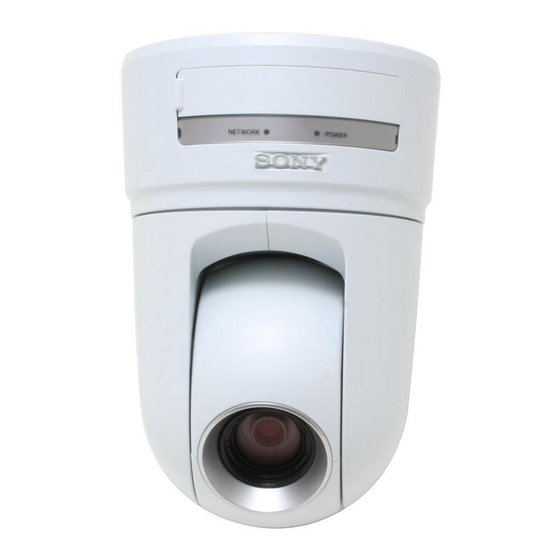Sony SNC-RZ25N - Network Camera Каталог - Сторінка 42
Переглянути онлайн або завантажити pdf Каталог для Цифрова камера Sony SNC-RZ25N - Network Camera. Sony SNC-RZ25N - Network Camera 44 сторінки. Ntsc/pal
Також для Sony SNC-RZ25N - Network Camera: Довідковий посібник (2 сторінок), Короткий довідник (20 сторінок), Брошура та технічні характеристики (6 сторінок), Інтеграційна примітка (4 сторінок)

GLOSSARY
Activity Detection
A method of detecting activity in an image. Activity detection
compares illumination levels between frames on a pixel-by-pixel
basis. If the average change in luminance level from one frame to
the next is greater than a pre-specified threshold, then an alarm is
triggered.
Automatic Gain Control (AGC)
Amplifies existing video to help camera reproduce a video signal at
very low light levels.
Adaptive Picture Control (APC)
Automatically detects the condition of the recording head and video
cassette tape and then sets the optimum recording head current.
Available on all SVT time lapse VCRs.
Adaptive Rate Control (ARC)
A technology that automatically detects and compensates for
network traffic when transferring MPEG-4 image data over a
network. In order to prevent "Drop Outs" when the network
becomes congested, ARC first lowers the data bit rate, and if the
network is still congested, then ARC lowers the frame rate.
Aperture/Sharp Mode
Makes object outline in the picture appear sharper. Ideal for
situations where an object merges into the scene with a similar
shade of color.
Auto Tracing White Balance (ATW)
Adjusts the white balance automatically in response to varying light
conditions.
ATW PRO
Ideal for frequently changing light conditions and applications where
the operator needs to see objects as they appear to the eye.
Effective operational color range is 2500 to 6000K.
Auto Iris
Automatically adjusts the iris element as the light level changes.
Auto White Balance (AWB)
Automatically memorizes adjusted white balance values.
Backlight Compensation (BLC)
Picture brightness is adjusted automatically depending on lighting
conditions. Overcomes the problem of strong backlight which often
causes the subject of the picture to be cast into shadow.
C Mount
Type of camera mount which measures 17.5 mm from the lens rear
mounting surface to the camera's CCD.
CS Mount
Type of camera mount which measures 12.5 mm from the lens rear
mounting surface to the camera's CCD. CS mount lenses can be
used with C mount cameras by adding a 5 mm spacer.
DC Servo Auto Iris Lens
Lens that relies on DC power from the camera to control the iris.
Digital Signal Processing (DSP)
Converts the analog signal from a CCD image sensor into a digital
signal through an internal A/D converter. The signal is then broken
down into luminance and chrominance components for processing,
adjustment and feature enhancement enabling many digital features
such as backlight compensation.
Duplex
Type of multiplexer allowing simultaneous live monitoring or
playback as images are being recorded.
DynaView Technology
A technology used to capture clear images even in extremely high-
contrast lighting environments. When using DynaView technology,
the camera actually captures the image twice - once at a normal
shutter speed and then at a high shutter speed - and creates a
composite high-contrast image.
Exwave HAD Technology
Sony technology employing advanced sensor structure within the
CCD resulting in improved sensitivity over Super HAD technology.
JPEG
A compression method used in conventional surveillance and
monitoring systems that is ideal for capturing high-quality still
images.
Motion Detection
A method of detecting motion in an image. Motion detection uses
vector information available and inherent in MPEG-4 compression.
Motion detection has an advantage over activity detection because it
can reduce the number of false alarms caused by noise.
MPEG-4
A compression method that takes into account only the movement
in an image when capturing data. MPEG-4 compression is ideal for
data that is transferred over networks because of its relatively small
data size.
Sensitivity
The amount of light falling on a scene measured in lx.
Simplex
Type of multiplexer which allows the user to choose between live
monitoring, recording or playback.
Smear
Vertical streaks above and below a brightly lit object or light source
when observed on the monitor. Vertical lines on the screen are
caused by the leakage of unwanted light onto the vertical shift
register of the CCD.
SuperExwave Technology
Sony camera technology that uses CCDs with advanced photo-diode
sensors capable of capturing a great amount of light especially in the
near infrared (IR) region of the spectrum. As a result, sensitivity
levels have been improved by the following percentages when
compared to Exwave HAD technology: Approximately 10% in the
visible region, and approximately 50% in the near IR region.
Super HAD Technology
Improves camera sensitivity by optimizing the shape of on-chip micro
lenses on the CCD in order to minimize the invalid area between
micro lenses of each pixel.
Synchronization
Used in multi-camera installations where automatic switching is
employed and allows roll-free switching from camera to camera.
Triple Multiplexing
Video, sync and power transmitted over a single coaxial cable.
41
